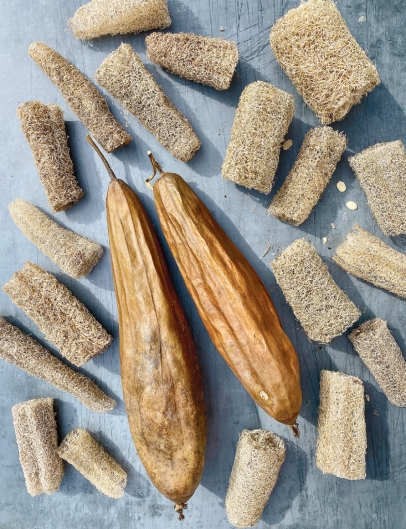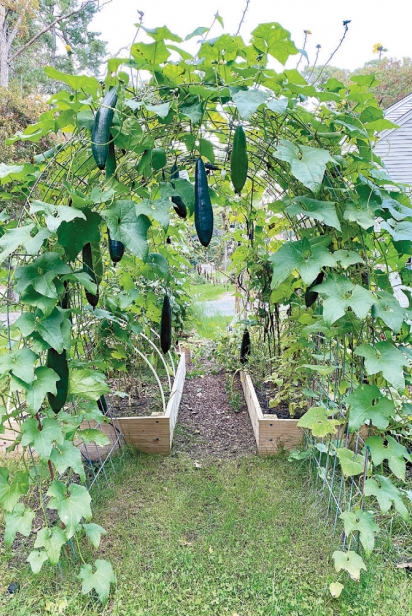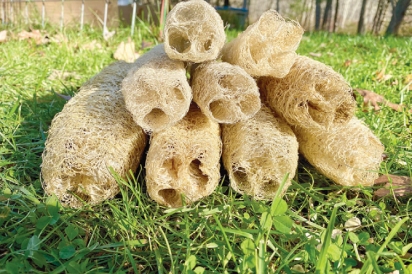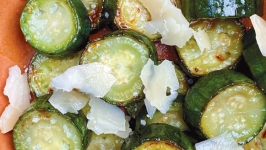There’s a Lot to Love About LUFFA
There’s a lot you probably don’t know about luff a. First of all, it’s not a sea sponge. I know, I had no idea either! My mouth was agape when this information was shared with me. For the better part of fifty years, I thought luff a, also spelled loofah, grew at the bottom of the ocean. That couldn’t be farthest from the truth. Secondly, luff a can be an unexpected gastronomic delight when its immature gourds are consumed like summer squash or zucchini.
Just as luff a comes in myriad shapes and sizes, it is also known by a variety of names: rag gourd, ridge gourd, sponge gourd, and my favorite, vegetable sponge. It’s neither a vegetable, nor a sponge! It’s also known as Chinese okra or angled loofah. According to Encyclopedia Britannica, loofah (genus Luff a) “is a genus of seven species of annual climbing vines of the gourd family (Cucurbitaceae), native to the Old-World tropics. Two species (Luff a acutangula and L. aegyptiaca) are commonly cultivated for their fruits, which are edible when young and have a fibrous spongelike interior when fully matured that is used domestically for bathing and for washing dishes.”
In my experience, growing luff a from seed is quite easy. All you need is a lot of vertical space for its hardy, climbing vines and its ever-coiling tendrils, and a lot of patience. While it doesn’t need much tender loving care, like tomato or pepper seedlings, luff a does need time to reach maturity (approximately 110-130 days), especially if you hope to use them to exfoliate your suntanned face after a long day at the beach, or to scrub your lobster pots with them after a clambake. If you are interested in only growing young luff a to eat, then you’ve got some wiggle room. On the Cape, the plant hardiness zone you live in will determine when you need to begin sowing seeds indoors. If you look at The Arbor Day Foundation U.S. Hardiness Zone Map, as with all hardiness zone maps, you’ll notice that the smaller the number, the colder the zone. Folks living in zone 7, for example, may experience average annual low temperatures of 10°F through 0°F, whereas people living in zone 6 may experience average annual low temperatures of 0°F through -10°F. It may not seem like a really big deal to us, but for vegetation, it’s a whole different story. Hyannis is located in plant hardiness zone 7a, whereas Sandwich is in zones 6b and 7a, and Bourne is in zone 6b. Subtle differences, but differences to be sure.
Even Baker Creek Heirloom Seeds pays homage to this versatile fruit, with the inclusion of an 1888 Burpee’s catalog description of luffa. “The fruit grows about two feet, and the vine is very ornamental, producing clusters of yellow blossoms, in pleasing contrast with the silvery-shaded, dark green foliage. In the North, this variety requires starting in a hotbed.” While Victorian green thumbs didn’t have the same variety of seed starting stations and grow lights available to them that today’s gardeners do, they apparently revered the luffa. Unfortunately for them, their admiration didn’t go any farther than using them as “a natural dishcloth, and a most admirable one.”
According to a study entitled, “Therapeutic Potential of Luffa acutangula: A Review on Its Traditional Uses, Phytochemistry, Pharmacology and Toxicological Aspects,” conducted by the National Library of Medicine (2018), luffa is “a perennial plant [that] grows mainly in India, Southeast Asia, China, Japan, Egypt, and other parts of Africa, it is widely used in the traditional Indian medicinal system to treat various health conditions.” While it appears luffa has numerous traditional uses, above and beyond being used as a side of nutritious greens on your plate, I found the following information to be quite intriguing. “The dried fruit powder is useful in preventing premature graying of hair.” I don’t know how this works, but say no more. I shall grow twice as many luffa in my garden this year! But if anyone asks, it’s because I really, really like its pretty yellow flowers. All joking aside, this extremely thorough study reminded me why I did so poorly in high school chemistry class, but it’s definitely worth the deep dive if that’s your thing.
Another study about luffa, which was published in 2019 by the Pharma Science Monitor, is much more palatable to digest. “Ridge gourd acts as an appetizer and it is a healthy food and contains good amounts of fiber, vitamins and minerals including Vitamin B2, Vitamin C, carotene, niacin, calcium, phosphorus, iron and small quantities of iodine and fluorine. Ridge gourd has a sweet taste, cooling in nature and easy to digest. They form a low-calorie diet, which is considered good for diabetes. Both the soft pulp and skin of ridge gourd are used in making various recipes, especially in South Indian cuisine. Chutneys made from the pulp and the peel of ridge gourd is known for their health benefits.” While I’ve never made chutney with luffa pulp before, I’m definitely interested in testing one of the many recipes that are available online. Each recipe is different from the other, but the inclusion of chiles, cumin, and mustard seeds seem to be fairly consistent. I would expect the chutney to not only be flavorful, but aromatic.
As I write this article, temperatures are hovering around 55°F, bright orange and yellow tulips are giving my mostly barren garden a much-needed burst of color, robins are feverishly making nests, and tree buds are near bursting. The luffa seedlings that were started in March have been transplanted into reusable plastic cups (with holes at the bottom) are happily spending their days under grow lights until they can be hardened off outside within the next few weeks. Once the soil temperature warms up to about 70°F, I’ll plant them at the base of a simple, cattle panel trellis held in place with steel rebar. There, over the next few months, their vines will continue to creep, ever so slowly, up the trellis. They don’t look like much now, but have faith. As few as three luffa plants can produce over 20 luffa. If new luffa begin growing in August or later, pick them while they are young, and eat them. More likely than not, they will never reach full maturity before the first frost.
I learned this the hard way last year. Throughout the summer, I only picked a few young luffa to eat, because I envisioned giving luffa scrubbers to all of my family and friends over the holidays. Instead, some of what I harvested at the end of the growing season were luffa that were neither immature nor mature. When they were peeled open, they resembled something Shrek would have adored. They were both mushy and fibrous, inedible and unusable. It was not pretty.
Don’t be deterred, though. Luffa plants don’t succumb to the dreaded squash vine borer like summer squash and zucchini do. If powdery mildew begins growing on its leaves, it can easily be controlled. You can spray Neem oil on the affected areas, or even make an apple cider vinegar and water mixture. Luffa love. It will not disappoint you.








